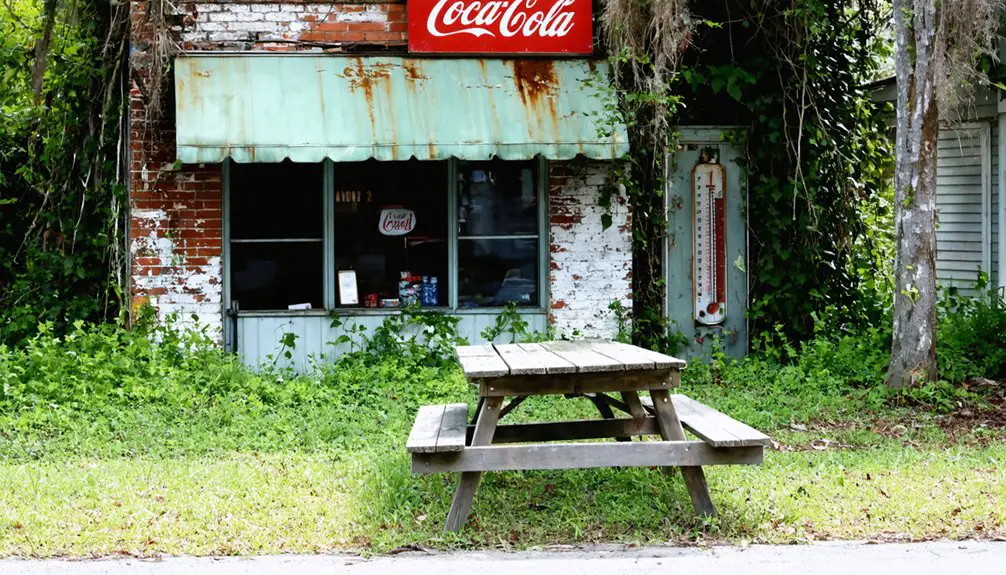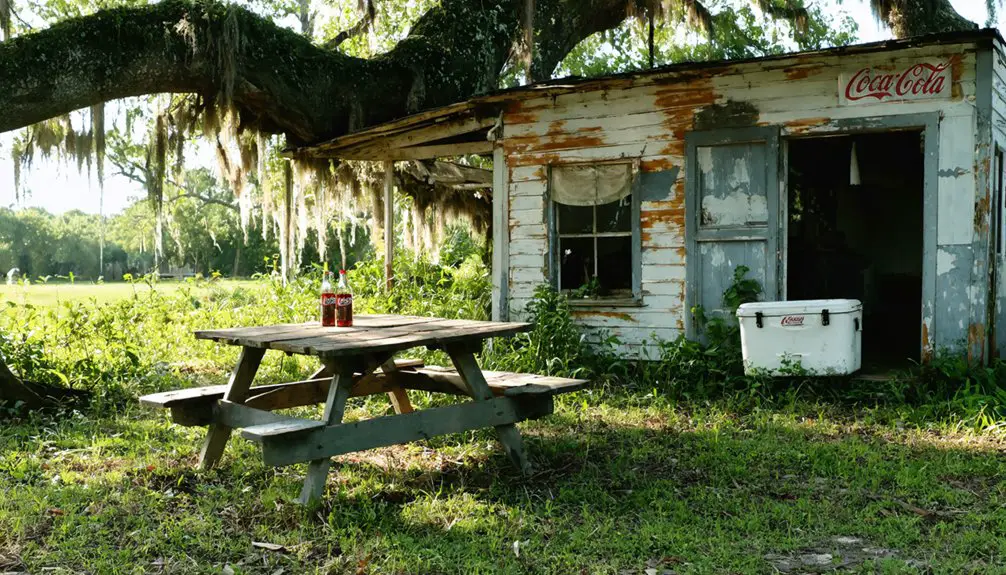You’ll find the remnants of Picnic, a modest rural ghost town from the late 1800s, along Hurrah Creek in Hillsborough County, Florida. Unlike larger abandoned settlements like Ellaville with its 500-worker sawmill, Picnic remained a small community of about 300 residents focused on farming and fishing, with two wooden bridges crossing the creek. While historical records are limited, the site’s hiking trails and cemetery hold clues to its understated past.
Key Takeaways
- Picnic was a small Florida ghost town with a peak population of approximately 300 residents, featuring two wooden bridges over Hurrah Creek.
- Unlike other Florida ghost towns, Picnic lacked major industries and operated primarily as an informal community with modest farming and fishing.
- Historical documentation of Picnic is limited, with few official records compared to other ghost towns like Ellaville or Indian Key.
- The town’s main features included a grocery store and basic infrastructure, but it never developed substantial economic or industrial activities.
- Today, visitors can explore Picnic’s remains through hiking trails and view historic structures like the Hillman Bridge and limestone banks.
The Mysterious Origins of Picnic
When George Franklin Drew founded Ellaville in 1861, he established what would become one of Florida’s most notable post-Civil War industrial towns.
You’ll find its origins deeply rooted in Drew’s personal history, as he named the settlement after Ella, his African-American servant, breaking from traditional naming conventions of the era.
While the picnic origins and picnic legends of this region aren’t directly tied to Ellaville’s founding, Drew’s vision transformed the Suwannee River banks into a thriving community. Like many small Florida settlements, the town emerged at the intersection of county roads.
After receiving cotton compensation following the Civil War, he partnered with Louis Bucki to build Florida’s largest steam-operated sawmill.
Drew’s grand mansion became the town’s first major structure, marking the beginning of a settlement that would soon bustle with over 1,000 residents, a reflection of the entrepreneurial spirit of post-war Florida. The mansion was exceptionally modern for its time, featuring indoor plumbing and electricity.
Life in Early Rural Hillsborough County
During the 1840s, rural Hillsborough County experienced a dramatic population surge as Anglo-American settlers transformed the landscape. You’d find these pioneers, many from the Carolinas and Georgia, establishing scattered homesteads several miles apart to accommodate their cattle-ranching needs. Each family required vast tracts of unfenced range, typically needing two dozen acres per cow.
The rural lifestyle centered around pine-log houses where families balanced livestock raising with growing crops like corn, sweet potatoes, and citrus. Early settlers enjoyed success with orange grove cultivation, following a pattern that would help establish Hillsborough as a top citrus producer by the 1880s. The Allens became prominent in the area when they established the first store on Boy Scout Road to serve the growing farming community.
Despite the physical distance between homesteads, strong community bonds formed through monthly church gatherings in mud-chinked Methodist buildings. Riders like Byrd Sparkman maintained social connections by alerting settlers to services.
Local economies diversified with sawmills, turpentine stills, and shared agricultural practices, creating tight-knit farming communities like Dover.
Distinguishing Facts From Local Legends
When you research ghost towns like Picnic, you’ll need to carefully distinguish between documented historical records and local hearsay.
By examining primary sources such as deeds, census data, and period newspapers, you can separate verified historical facts from embellished local legends that have emerged over time. Similar to how tangible remains of Florida’s ghost towns are often hidden beneath years of growth and development, the true historical facts require dedicated research to uncover. Like the story of Drew’s sawmill, which historical records confirm was once Florida’s largest and employed over 500 workers, concrete evidence helps validate local tales.
You’ll find that cross-referencing multiple historical documents helps establish the most accurate account of Picnic’s past while identifying which popular stories lack supporting evidence.
Historical Records vs. Hearsay
While distinguishing historical fact from local legend poses challenges for many ghost towns, Picnic, Florida’s documented history sharply contrasts with its colorful folklore.
Historical accuracy comes from property deeds, census records, and railway documents that paint a picture of a modest agricultural settlement that gradually declined rather than suddenly vanished. Similar to how severe freezes destroyed the citrus crops and livelihoods in Norwalk and Sisco, leading to their abandonment, documented evidence shows Picnic’s slow economic deterioration. You’ll find that official records directly contradict popular oral traditions about abrupt abandonment, hidden tunnels, and vast wealth.
When you examine the evidence, you’ll see how census data tracks a steady population decrease over decades, while architectural studies reveal that some buildings claimed as original Picnic structures actually stood in neighboring towns.
The town’s documented economic activities centered on small-scale farming and fishing, not the dramatic tales of outlaw hideouts or buried treasures that persist in local storytelling.
Separating Myths From Documentation
Unlike common ghost town lore, Ellaville’s documented history rests firmly on archaeological evidence and official records rather than sensational tales.
While mythical narratives often surround abandoned towns, you’ll find Ellaville’s story backed by concrete facts and physical remains. Today, visitors can explore the town’s history along the Earthworks Trail that winds through the historic site.
Key documented historical elements include:
- George Franklin Drew’s verifiable role as founder and his connection to naming the town after his servant Ella
- The precise location and remains of Florida’s largest sawmill operation during the town’s peak
- Physical evidence of infrastructure including the Hillman Bridge foundations and steamboat dock ruins
The town’s decline is similarly well-documented through economic records and environmental data, showing how the Great Depression and devastating floods, not supernatural events, led to its abandonment.
Local Stories Under Scrutiny
Throughout Ellaville’s documented history, you’ll find a fascinating interplay between verifiable facts and colorful local legends.
While Ellaville anecdotes tell of ghostly figures near Hillman Bridge and supernatural happenings at Suwanacoochee Spring, historical records paint a more grounded picture of a thriving lumber town built around Drew’s sawmill.
Local folklore often romanticizes the town’s social gatherings and suggests an overnight abandonment following the 1930s flood.
However, archaeological evidence and historical documentation reveal a gradual decline tied to economic factors, particularly the logging industry’s downturn and Great Depression.
You can still verify many true elements of Ellaville’s past through preserved structures, historical markers, and remains within Suwannee River State Park, which help separate authentic history from embellished tales.
Comparing Picnic to Notable Florida Ghost Towns

Unlike established ghost towns such as Elaville with its substantial sawmill operations or Beecher Springs with its mineral spring tourism, Picnic never developed significant economic infrastructure or documented industries. Similar to how video content remains unavailable today, historical records about the settlement are inaccessible.
You’ll find no population records or formal development plans for Picnic, in stark contrast to Florida’s notable ghost towns that maintained detailed accounts of their residents and commercial activities.
While places like Elaville left behind physical remnants of mansions and industrial sites, Picnic’s limited historical footprint suggests it functioned more as an informal community rather than a structured town. The area’s only notable structures were two wooden bridges that spanned across Hurrah Creek.
Size And Economic Differences
Among Florida’s abandoned settlements, Picnic stood as one of the smaller ghost towns with roughly 300 residents at its peak, while other notable ghost towns boasted markedly larger populations.
The population dynamics varied greatly across these forgotten places, with Indian Key reaching 1,700 residents and the Weeki Wachee sawmill town hosting 1,500 inhabitants.
Economic factors shaped these towns’ distinct characters:
- Picnic relied on modest farming, fishing, and a single grocery store.
- The sawmill town thrived on industrial-scale timber processing.
- Phosphate towns like Bradley Junction operated with extensive mining infrastructure.
While Picnic maintained a small but steady existence before fading away, other ghost towns experienced more dramatic rises and falls tied to their industrial foundations, environmental disasters, or military conflicts.
Population Records Versus Others
When comparing population records of Florida’s ghost towns, Picnic’s peak numbers remain less documented than those of its contemporaries during the late 1800s.
Unlike Oriole, which had clear population estimates of around 100 residents before its 1898 abandonment, or Fruitland Peninsula’s well-tracked demographic shifts from 265 to 100 people between 1889-1895, Picnic’s historical records are conspicuously sparse.
You’ll find more complete documentation for larger settlements like Muskogee Mills, where company records tracked thousands of residents during lumber boom years, or Lawtey, which maintained census data showing over 600 residents into the late 20th century.
While local histories and railroad maps mention Picnic’s existence, its population figures haven’t survived in formal census records or company documents.
What Remains Today: A Ghost Town Explorer’s Guide
Although many ghost towns leave little evidence of their existence, Picnic’s remnants offer explorers a tangible connection to Florida’s industrial past.
Picnic’s ghostly remains stand as silent witnesses to Florida’s bygone industrial era, inviting modern explorers to touch history firsthand.
You’ll discover ghost town remnants and historical artifacts scattered throughout Suwannee River State Park, where nature slowly reclaims the town’s industrial heritage.
When you visit, you’ll find:
- The intact Hillman Bridge offering dramatic views of limestone banks and the old railroad bridge
- A preserved sawmill flywheel displayed in the park, representing the town’s logging legacy
- An old cemetery along River Road that tells the stories of former residents
You can explore these sites via well-marked hiking trails ranging from 1 to 2.3 miles.
The park provides essential amenities like parking and picnic areas, making it easy to spend a full day uncovering Picnic’s forgotten story.
Preserving the Memory of Lost Communities

Preserving the memory of lost communities like Picnic requires a multifaceted approach that combines heritage tourism, community involvement, and physical preservation strategies.
Through focused heritage preservation efforts, you’ll find local residents leading tours, managing small museums, and sharing oral histories that keep the town’s legacy alive.
Community engagement plays an essential role in protecting both tangible and intangible aspects of Picnic’s past. You can participate in educational workshops that strengthen local understanding of the town’s history, while volunteer programs help maintain preserved structures and artifacts.
Digital documentation, including virtual tours and online archives, makes Picnic’s story accessible to a global audience. By balancing tourism development with conservation efforts, you’re helping guarantee that this lost Florida community’s heritage remains protected for future generations to explore and understand.
Frequently Asked Questions
What Native American Tribes Originally Inhabited the Picnic Area?
You’ll discover the Tocobaga Native tribes dominated this area’s cultural heritage first, living there until the 1600s, before Seminole peoples, who emerged from Creek migrations, settled the region during the 1700s.
Were Any Civil War Battles or Skirmishes Fought Near Picnic?
You won’t find any documented Civil War battles or local skirmishes in the area. The nearest major engagement was at Olustee Battlefield, about 150 miles north-northwest of your location.
What Natural Disasters Have Affected the Picnic Region Historically?
When floodwaters breached Lake Okeechobee’s levee in 1928, you’d have witnessed the region’s deadliest disaster. The hurricane impact killed thousands, while other floods, tornadoes, and freezes have shaped the area’s history.
Did Any Famous Outlaws or Criminals Ever Hide in Picnic?
You won’t find any verified reports of outlaw hideouts or criminal legends in Picnic. Historical records don’t support claims of famous fugitives using this rural settlement as a sanctuary.
What Was the Closest Railroad Station or Transport Hub to Picnic?
You’ll find that Ellaville’s station was likely the closest rail hub to Picnic, marking significant transport history in Florida’s railroad network, though exact distances aren’t confirmed in historical records.
References
- https://ghosttownadventures.wordpress.com/2021/06/20/picnic/
- https://www.worldatlas.com/travel-stories/north-florida-s-infamous-ghost-town.html
- https://www.youtube.com/watch?v=zgf6tE2mrCU
- https://www.atlasobscura.com/places/the-ghost-town-of-ellaville-madison-florida
- https://www.tiktok.com/@socialshepherdadventures/video/7342301852702100778
- https://cccourthouse.org/wp-content/uploads/2023/12/Ghost-towns-and-Cemeteries-of-Citrus-County.pdf
- https://www.florida-backroads-travel.com/florida-ghost-towns.html
- https://www.youtube.com/watch?v=3mDsPKA4B2o
- https://stars.library.ucf.edu/cgi/viewcontent.cgi?article=3683&context=fhq
- https://patchproflorida.com/blog/the-history-of-hillsborough-county/



